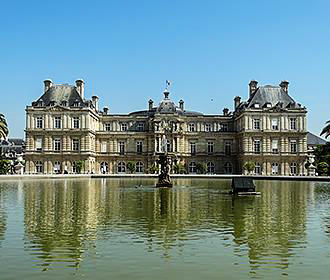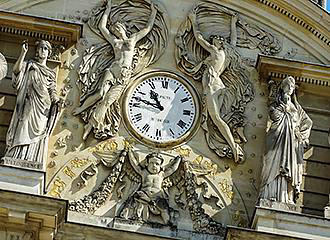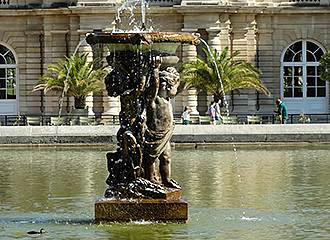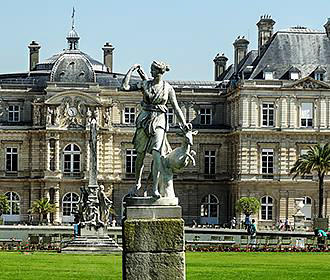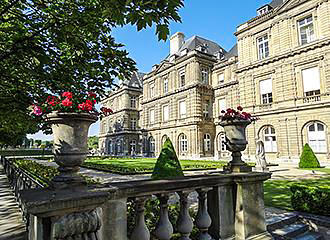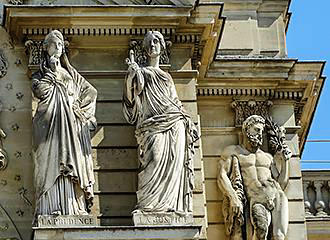Historical Paris Palais du Luxembourg
This historical building was originally constructed in the 1600s and declared a National Palace in 1791, then after the French Revolution it became home to the French Senate, which it still is today, and located within the Jardin du Luxembourg gardens, you have the opportunity of discovering this incredible Paris monument.
About the Paris Palais du Luxembourg
Although the Luxembourg palace was first constructed during the early part of the 1600s for Marie de Medici, you will find that the Palais du Luxembourg history is rich and varied, and first being a palace, it became a prison for a short while during the French Revolution, then became the House of Peers during the Empire, and then home of the French Senate.
But unfortunately Paris Palais du Luxembourg has had numerous changes over the years, which meant that much of the original decoration has been lost over time, especially with the changes that Napoleon Bonaparte I made, however, Palais du Luxembourg is still home to the French Senate today, and is classed as an historical Paris monument, with renovations continuing to preserve the ornate decor of its impressive interior.
Some of the Luxembourg Place elements and paintings have been kept, just like within the Golden Book Room and its ceiling paintings, although these are by unknown artists, but the chamber itself, which is made up of two hemicycles only dates from the 1800s and was finished in 1841.
The Palais du Luxembourg Conference Hall East is decorated in a Second Empire style, which is where Senators can read the daily newspapers, and this is where you can find a beautiful ceiling painting. Yet the Conference Hall West was once the main hall that led to the original staircase and chapel of Marie de Medici, but Napoleon I had his Senate Chamber place here, then Napoleon III had this changed into a large ballroom.
The Messengers of State Room used to be the entrance hall to the private and public apartments of Marie de Medici, and this has ornate gilding, large oil paintings, a fresco painted ceiling called Law produced in 1840 by Henri Decaisne, a marble statue depicting the God of Silence and much more.
In the west wing of the Paris Palais du Luxembourg, you will see the monumental staircase with its coffered vault, embedded ionic columns and carved Nubian lions, which was constructed by the architect Chalgrin, along with tapestries hanging on the walls between the windows. And used for ceremonial purposes, it also leads to the Rubens Gallery where 24 paintings by Ruben originally hung, although these are now within the Musee du Louvre.
Another area within the Luxembourg Palace is called the Gallery of Busts, which is where the President of the Senate walks past before the first sitting of the day, which leads to the Plateau, and contains busts of past senators and politicians. And talking of The Plateau, here you can see statues of famous people including Colbert, the Minister to King Louis XIV and Malesherbes, the Minister of state who was guillotined in 1784.
If you are lucky enough to be able to visit the Palais du Luxembourg, then you will also get to discover the Victor Hugo Room, which is next to the Conference Hall, and here you can discover the throne that Napoleon Bonaparte I used when he came to preside over debates, and it has a monumental chimney with a bust of Victor Hugo above the hearth and mantelpiece, who was a writer and a French Senator.
You could also discover the Library, which is essential to the staff and senators for their work, and specialising in law and economics, there are over 400,000 different volumes, but there is also an annex library in another part of the Luxembourg Palace that has archives and other books amounting to over 170,000.
So as you can no doubt tell, this is an elegant palace located right in the city itself, yet still serves a major purpose of being home to the French Senate, who are also responsible for the Jardin du Luxembourg and the other historical Paris monuments that are located within it, like the Petit Luxembourg.
Visiting the Paris Palais du Luxembourg
Visits to the Palais du Luxembourg are available on a Monday, Friday and Saturday for groups of up to 40 people when the Senate is not in session, yet a reservation must be made prior. These can be organised from 1st October for the first half of the calendar year, and from 1st April for the second half of the calendar year by telephone on +33 (0) 1 42 34 20 60.
Individuals can also visit the Luxembourg Palace and the Senate, which are available on one Saturday each month. However, you have to contact the Centre des Monuments Nationaux by telephone +33 (0) 1 44 54 19 30 in order to arrange this, and places are limited, so it is recommended to do this well in advance.
Yet you can also attend a session in the Palais du Luxembourg chamber, but you must report to the Senate reception with identification, and Gallery Tickets, as they are known, are distributed subject to availability for public sessions, which are normally held on Tuesdays, Wednesdays and Thursdays.
The only other times that the Paris Palais du Luxembourg and the Senate are open to visitors is normally on the National Heritage days, and on occasional days during school holidays, although, again you would need to contact the National Monument Centre to check on the details for the days and times.
But even if you are not lucky enough to be on holiday in Paris when the Luxembourg palace is open to the public, you can still admire the beautiful architecture outside, along with enjoying the many features such as the Medici Fountain and the Musee du Luxembourg, which are located within the Jardin du Luxembourg.
Access to Paris Palais du Luxembourg
So when it comes to getting here via Paris public transport, you will find the Palais du Luxembourg located in the 6th Arrondissement and the nearest Metro station is the Saint-Sulpice stop to the north serving line 4, or you have the Rennes stop to the west serving line 12, which is slightly further away.
Yet the nearest RER train station is the Luxembourg stop serving line B on the eastern side of the Jardin du Luxembourg Gardens, plus the Paris bus lines 21, 27, 38, 58, 82, 83, 84 and 89 along with the Noctilien Night Bus via Lines N14, N21 and N122 will also get you close by, as will some of the bus tours in the city like the company called Paris TootBus tours.
